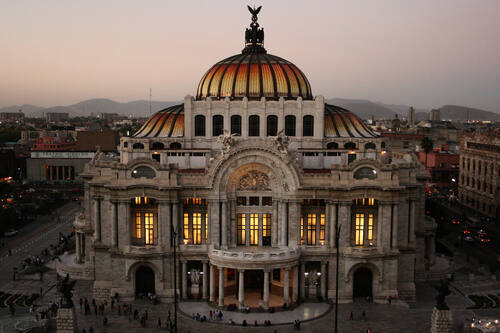Mexico offers a range of experiences that is as large as its geographical size. Driving through vast deserts for hours, sipping cocktails by the beach, visiting authentic and colorful markets, strolling through colonial towns, and exploring Mayan ruins are all possible in this spectacular country. Mexico features a total of 31 UNESCO World Heritage Sites, or those deemed by UNESCO to be of special cultural or physical significance. Here, we feature five of these amazing sites - if you are headed to Mexico, we highly recommend fitting at least one of them into your trip
1. Historic Centre of Mexico City
Declared a World Heritage Site in 1987, the "Centro Histórico" of Mexico City hosts a myriad of treasures. Built on the ruins of the ancient Aztec city of Tenochtitlan, its entire history from the construction of the pre-Hispanic city in 1525, through the country's independence from Spain is reflected in 1,550 historically important buildings. Its collection of archaeological sites and colonial and contemporary buildings include the Metropolitan Cathedral, National Palace, pre-Hispanic ruins of the Templo Mayor (Great Temple), and the Palace of Fine Arts. A variety of famous museums such as the National Museum of Anthropology, the National Art Museum, the Casa Azul of Frida Kahlo and Diego Rivera, and the Museum of Modern Art round out the cultural riches of the country's capital city.
 Palacio de Bellas Artes (17/02/2007) © Esparta / Esparta.
Palacio de Bellas Artes (17/02/2007) © Esparta / Esparta.
2. Historic Fortified Town of Campeche
Declared a World Heritage Site in 2002, Campeche combines history and culture with exuberant vegetation. This colonial harbor town served as a starting point for several major expeditions. Its historic center is still surrounded by intact walls that were commonly used in the 17th and 18th century to protect cities and towns against invading pirates.
This hotel used to be one of the haciendas, beautifully designed by famous European architects, for a flourishing sisal industry in the Yucatán Peninsula in the 1920s. By the 1990s, the magnificent sisal haciendas lay abandoned, and Puerta Campeche is bringing back to life not only this and other former sisal haciendas, it is also committed to the socially and environmentally sustainable development of rural Maya communities. The Hacienda is certified by the Earthcheck program.

3. Pre-Hispanic City of Chichén Itzá, Yucatán
Declared a World Heritage Site in 1988, this is one of the most famous Mayan ruins in the world and one of the most important examples of Mayan-Toltec civilizations. Buildings such as the El Caracol Great Ball Court, Temple of Kukulkan, El Castillo, and Temple of the Warriors are counted among the masterpieces of Mesoamerican architecture. Moreover this pre-Hispanic city was voted one of the seven new wonders of the world.
This beautiful lodge is located in the heart of the Chichen Itzá archeological area. The lodge even features a direct entrance to this fascinating pre-Hispanic city. Its cabins were built in a traditional Maya style, adhering to ecological criteria such as using tropical woods, marble, and palm fronds, yet all cabins are equipped with modern-day conveniences. This Rainforest Alliance Verified lodge serves as a forum for expression and interpretation of Maya traditions, uses, and customs. Located on 62 acres (25 hectares) with beautiful subtropical gardens, it is hard not to be relaxed and inspired after a visit here.

4. Sian Ka'an Biosphere Reserve
Meaning "Origin of the Sky" in Mayan, Sian Ka'an was established as a World Heritage Site in 1986. Located on the Caribbean coast of the Yucatán Peninsula, this beautiful reserve is a nature lover's paradise – it contains tropical forest, mangroves and a section of the Mesoamerican Barrier Reef. Local tour operators offer kayak trips through ancient Mayan lagoons that served as trade routes, excellent opportunities to observe the more than 300 bird species that live in the reserve. A total of 103 mammal species have been found here, including jaguar, puma, ocelot, tapir, manatees, spider and howler monkeys, deer, anteaters and more. Four species of endangered sea turtles - green, hawksbill, loggerhead, and leatherback- nest on the reserve's beautiful beaches.
Located in Tulum, a charming town just north of the Sian Ka'an Biosphere Reserve, Papaya Playa lies on a spectacular white sand beach. The hotel enhances its beautiful natural surroundings to create an atmosphere for guests to relax their minds and bodies. Moreover, the hotel helps preserve native plants, carries out reforestation projects, and protects sea turtles that nest in the area. It also participates in local community programs and supports organizations such as the local Red Cross.

5. Pre-Hispanic City and National Park of Palenque
Palenque is one of the most impressive ancient Mayan sites. Located in the lush green jungle of the Lacandon forest in the state of Chiapas, this site boasts well-crafted architecture and beautiful sculptural art. From 600 to 900 A.D. when at its peak, the site's influence extended over what are today the states of Chiapas and Tabasco.Its most famous buildings are The Palace and the Temple of Inscriptions.
Centro Ecoturístico Las Guacamayas (Las Guacamayas Ecotourist Center)
Named for the endangered scarlet macaw, the community-run Las Guacamayas Ecotourist Center hosts a macaw breeding program, an orchid garden, and a wildlife reserve. The community has also set aside 3,615 acres (1,463 hectares) of forest as a private protected area.



